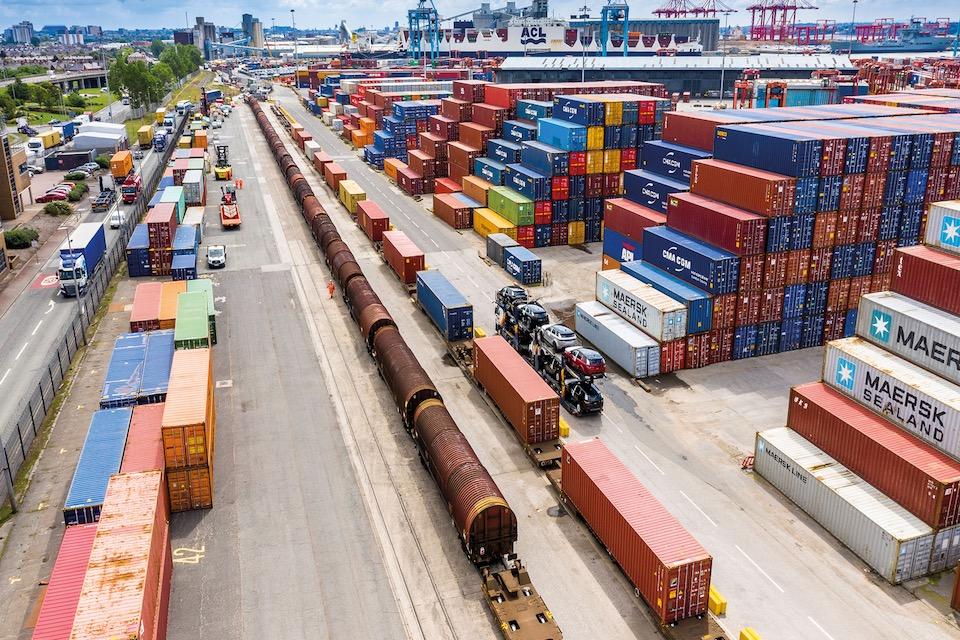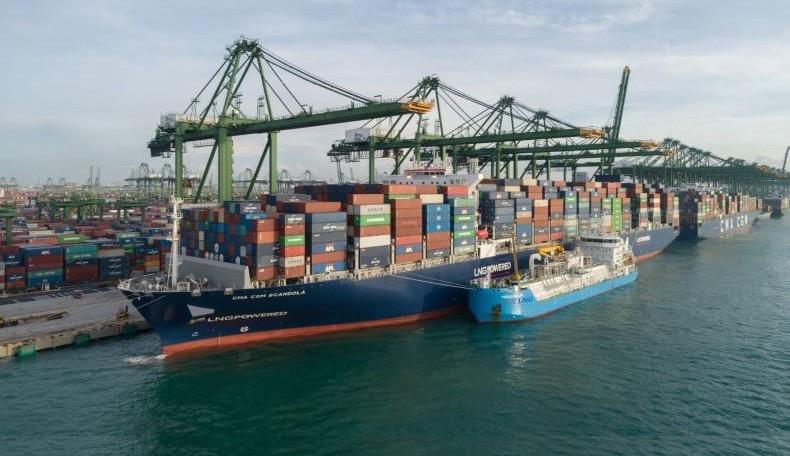
8 minute read
The Road to Net Zero
The challenges and barriers along the road to Net Zero, as well as new business opportunities, were discussed in-depth at a recent Coastlink webinar. Felicity Landon reports
“Despite what’s happening in the global economy with its trials and tribulations, there can be no bigger issue for us to face than the impact we have on the environment:” these were the opening words of Stephen Carr, Commercial Director, Peel Ports, UK as he delivered his presentation to the Coastlink webinar: The Road to Net Zero.
As evidenced by all the speakers, the road to Net Zero is far from smooth – it’s littered with contradictions, uncertainties, risks and frustrations – but Net Zero also brings opportunities for ports, shipping and the wider supply chain.
As Carr noted in relation to the fuels of the future for vessels and the mainstream grid supply: “It is hard for any port operator to invest a significant amount of capital when we don’t know which model we will be going forward with. Who takes the commercial risk when the future is so uncertain?”
And then there are the impacts on cargo flows through ports and into the hinterland; Alexandra Herdman, Public Policy Manager for Logistics UK, pointed out that while carbon-related cargo moved by rail (coal, etc), is steadily reducing, other cargoes are not rapidly occupying the resulting available capacity; hence rail freight levels have stayed relatively stagnant overall with a 10 per cent modal share.
When the UK government set its target for the country to be Net Zero by 2050, about 40 per cent of cargo moving through UK ports was carbon-related, said Carr. “That gave us 30 years for half of our marketplace to disappear. As we exit 2022, with 27 years left, it has fallen to 37 per cent. So, the good news is that a little bit of progress has been made – but the bad news is there is quite a way to go.”
THREE CATEGORIES
Carr considered the role of ports in achieving Net Zero and broke it down into three categories: how they reduce their own emissions; how they support Net Zero power generation; and how they enable cargo owners and movers to have more carbon-efficient supply chains.
Peel Ports has set a 2040 Net Zero goal as an operator – “an informed choice” after reviewing technology developments and its equipment replacement programme. The key point, however, said Carr, is that on the journey to Net Zero, “there is an awful lot we can do far quicker” – for example, converting diesel equipment from Marine Gas Oil (MGO) fuel, as undertaken at the Port of Liverpool where emissions are expected to be 20-30 per cent lower this year.
Meanwhile, different factors can support low-carbon supply chains – for example, Peel Ports restarted train services out of its container terminal a few years ago.
“For a long time, we have viewed shortsea shipping as an option and route to reduce total emissions from a total journey, but a final element is also to enable ships to refuel with lower or zero carbon fuels.”
Focusing on how ports can support Net Zero power generation, Carr said: “Ports need to really think about their role in supporting the production of Net Zero power. Have you got suitable road access – for example, as wind turbines get bigger, the junctions and roads in and out of the port estate need to be wider. Have you got the marine capability for deeper drafted or wider vessels to be able to support some of the new and emerging power generation areas?”
8 The Peel Ports-
owned Port of Liverpool has added major new rail container handling capacity and benefitted from linked track upgrades as part of its push for Net Zero
For example, a hydrogen cracker recently imported through the Port of Liverpool weighed in at about 100 tonnes. “This means having specialist lifting and handling capability, maybe different to what ports are used to. There are some very real challenges; the Highways England team believe this was the single largest piece of project cargo to have ever gone on to the UK road network. It straddled two carriageways of a motorway. While this will be an extreme example of what we need to deal with, this demonstrates some of the challenges that ports need to start to understand if we are supporting the generation of Net Zero power,” said Carr.
When it comes to refuelling vessels, one size doesn’t fit all, he noted. It is easier to commercialise a new solution for roro, where a ferry makes multiple calls a day, as opposed to bulk berths, where the size and shape of vessels varies on a day-to-day basis.
“The second issue is, who takes the commercial risk? What happened in the biomass market ten years ago was the Government provided the power generation grants, long-term commitments on price, and that cascaded down the supply chain so people could invest in the infrastructure needed.”

TAILORED APPROACH
Tanya Ferry, Green Port Consultant at Royal HaskoningDHV, also emphasised that all ports are unique. “Options to reduce emissions need tailoring every time. Ports are often complex with multiple players, with site users including the port/ terminal operator, shipping, the logistics chain, etc. In its favour, she pointed out, it is quite a competitive sector, and we are starting to see quite a competitive nature around emissions reduction and a green corridor approach in ports.”
As for where to begin: “Often the question is, where are we starting from? The baseline is key, and benchmarking is the starting point.”
Ports must identify what can and cannot be controlled and any influence they can have, said Ferry. The key is identifying opportunities and building a long-term strategy.
For most ports, the largest source of their own emissions is likely to be diesel-powered plant in cargo handling and storage areas, she said. Reductions can be linked to both technology and staff actions: “Streamlining operational efficiency is a key dual benefit opportunity, as well as designing for low carbon and low maintenance.”
However, the vast majority of emissions in ports are derived from visiting vessels, said Ferry. Digital tools can help here, by optimising port call movements and performance.
This is not just about ‘being green’ but definitely about ‘being smarter’, she insisted, and data is going to be very important in the future. “There is technology out there for monitoring air quality and other emissions in real time. Things like AIS exist and can be a strong tool. A lot of work is being done around data collection and digital twin work has been really important in helping ports see what they can achieve going forward.”
RAIL AND WATER SUPPORT
One of the most important ways to reduce transport emissions over the medium term during the transition to electric and alternative fuels is switching freight from road to rail and water, said Alexandra Herdman, Public Policy Manager, Logistics UK.
She outlined the benefits of this shift in terms of reducing emissions and road congestion and improving air quality: a barge fully loaded with aggregate can do the job of 17 HGVs and a freight train can take 76 HGVs off the road.
However, there are challenges to modal shift and it is vital that the barriers to water and rail freight are broken down, underlined Herdman.
On the water side, there has been a significant loss of infrastructure and access to wharves, while the loss of industrial land along waterways makes it very difficult to get access to wharves.
Logistics UK wants the UK Government to provide more incentives and certainty for the maritime sector to support the move away from fossil fuels. Herdman also called for a review of the grant funding model for modal shift, the reintroduction of the Freight Facilities Grant and the setting of growth targets for water freight, similar to those proposed for rail.
8 Digital solutions
have a big role to play in emission reduction – e.g. optimising vessel arrival times onberth – CMA CGM has adopted PSA’s OPT-E-Arrive digital solution
Amsterdam: The Challenge for an Energy Port
The final speaker, Mark Hoolwerf, deputy director of the Port of Amsterdam gave clarity on the enormous impact of Net Zero. “The Port of Amsterdam is really an energy port; two-thirds of our cargo is related to oil products or coal, so that means we have quite a challenge to achieve our goals,” he said. The big step was a decision in 2016 to phase out coal-handling through the port by 2030: “That means you have to look for a viable and clean alternative.”
Amsterdam is aiming to be ‘at the forefront of the transition’ and ultimately aims to evolve into a European hydrogen hub, he said.
“The focus for us is very much on hydrogen. Green hydrogen is deemed vital for the decarbonisation of the three main industrial clusters in the port region.”
At present, Tata Steel uses 5m tonnes of coal a year; Schiphol airport, directly connected by pipeline, consumes 4m tonnes of aviation fuel; and port activities, including bunkering, consume 45m tonnes of fossil fuels.
“We have a number of green hydrogen facilities being developed in the port, courtesy of the large offshore wind farms in the North Sea. However, total demand that will happen in the Netherlands means we can never provide enough for the hinterland. We are looking at fostering relationships to be able to import green hydrogen into the port.”








